-
Countries
-
Data and Analysis
-
Special Focus
-
Crisis Responses
Displacement Report
Country
Title Standard
Mozambique — Displacement Report {#} ({DATE})
Contact
DTM Mozambique, DTMMozambique@iom.int
Type
Component
Domain
Confidential
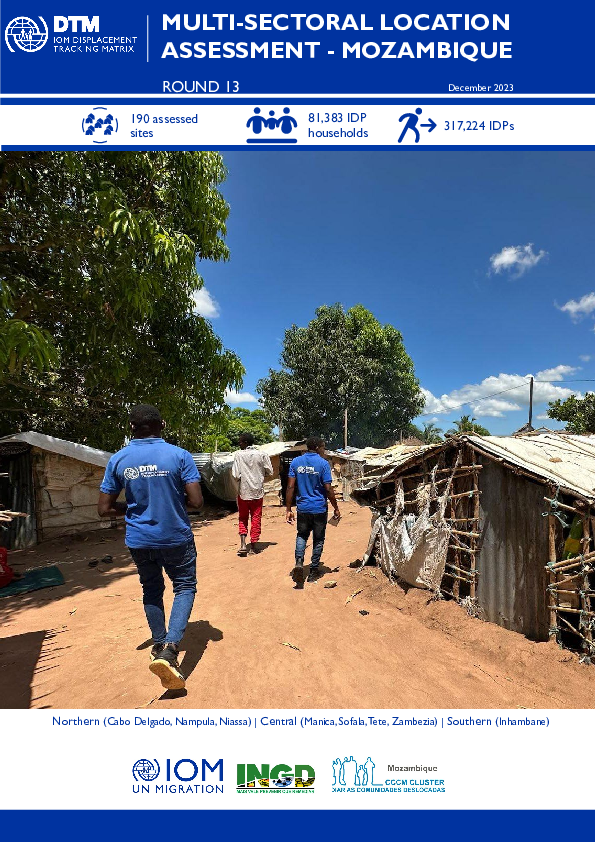
Contact
DTM Mozambique, DTMMozambique@iom.int
Language
English
Location
Mozambique
Period Covered
Dec 05 2023
May 29 2024
Activity
- Mobility Tracking
- Site Assessment
This Multi-Sectorial Location Assessment (MSLA) report, which presents findings from the International Organization for Migration’s (IOM) Displacement Tracking Matrix (DTM) Round 13 assessments, aims to enhance understanding of the extent of internal displacements and the needs of affected populations in conflict-affected and disaster-affected districts of Mozambique. Data was collected between 5 - 29 December 2023 in close coordination with provincial government and Instituto Nacional de Gestão e Redução do Risco de Desastres (INGD) partners, and presents trends from 190 assessed sites hosting internally displaced persons (IDPs) across Northern (Cabo Delgado 95 sites, Nampula 2 sites, Niassa 7 sites), Central Mozambique (Sofala 36 sites, Manica 35 sites, Zambezia 10 sites, Tete 3 sites) and Southern (Inhambane 2 sites).
A total of 317,224 (IDPs were reported present in all 190 sites assessed. This represents a reduction of 19 per cent from MSLA Round 12. Reported figures, however, exclude displaced individuals living in host community settings. According to DTM Round 20 Mobility Tracking Report, as of August, an estimated 709,529 were identified living in both host communities and sites (582,764 IDPs in Northern Mozambique, and 126,765 IDPs in Central Mozambique).
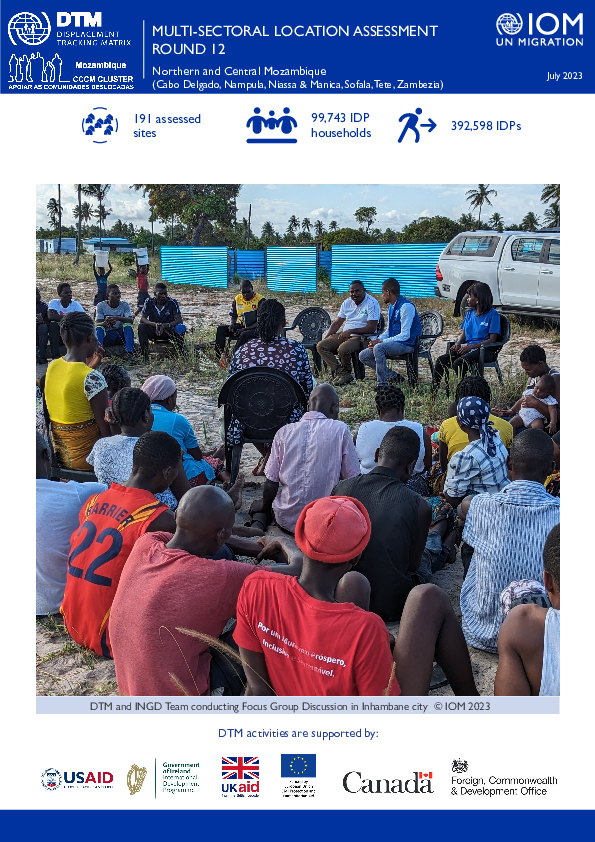
Contact
DTM Mozambique, DTMMozambique@iom.int
Language
English
Location
Mozambique
Period Covered
Jul 01 2023
Jul 31 2023
Activity
- Mobility Tracking
- Site Assessment
This Multi-Sectorial Location Assessment (MSLA) report, which presents findings from the International Organization for Migration’s (IOM) Displacement Tracking Matrix (DTM) Round 12 assessments, aims to enhance understanding of the extent of internal displacements and the needs of affected populations in conflict-affected and disaster-affected districts of Mozambique. Data was collected between 12 - 30 July 2023 in close coordination with provincial government and Instituto Nacional de Gestão e Redução do Risco de Desastres (INGD) partners, and presents trends from 191 assessed sites hosting internally displaced persons across Northern (Cabo Delgado 94 sites, Nampula 2 sites, Niassa 7 sites) and Central Mozambique (Manica 35 sites, Sofala 36 sites, Tete 4 sites, Zambezia 13 sites).
In total, 392,598 internally displaced persons (IDPs). This is much higher than MSLA Round 11, as all sites in Northern and Central Mozambique are now being analysed jointly. Reported figures, however, exclude displaced individuals living in host community settings. According to DTM Round 19 Mobility Tracking Report, as of August, an estimated 850,599 were identified living in both host communities and sites (668,939 IDPs in Northern Mozambique, and 181,660 IDPs in Central Mozambique).
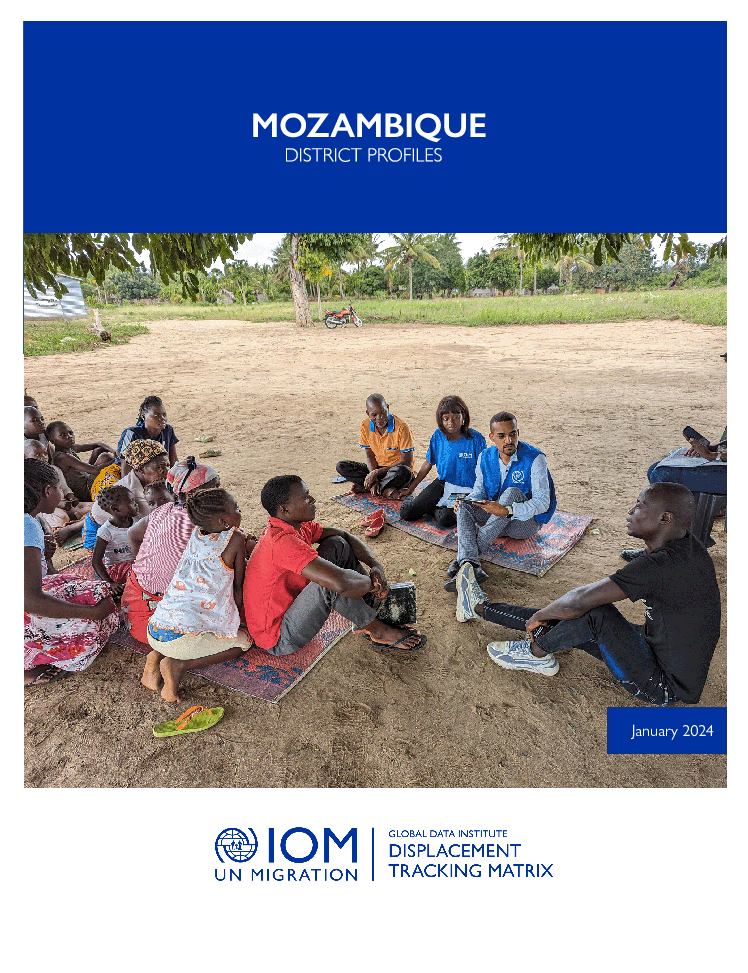
Contact
DTM Mozambique, DTMMozambique@iom.int
Language
English
Location
Mozambique
Period Covered
Dec 05 2023
Dec 29 2023
Activity
- Mobility Tracking
This district profile is part of our comprehensive analysis in the 20th round of Mobility Tracking Assessments. This one-pager per district succinctly summarizes the situation of IDPs in a specific district, focusing on IDPs population trends, demographics, origins, living conditions, and their most pressing needs.

Contact
DTM Mozambique, DTMMozambique@iom.int
Language
English
Location
Mozambique
Period Covered
Dec 05 2023
Dec 29 2023
Activity
- Mobility Tracking
This summary presents findings of the 20th round of Mobility Tracking Assessments (previously known as Baseline Assessments) conducted across Northern, Central and Southern Mozambique through key-informant and group interviews at location level between November and December 2023. Mobility Tracking assessments provides a geographical overview of demographic and mobility profiles of internally displaced persons (IDPs) and returnees across Mozambique. During this round, IOM DTM mapped a total of 709,529 IDPs and 632,408 returnees in 364 locations. Cabo Delgado hosts 76 per cent of the overall IDP figure followed by Sofala (11%). Estimated 55 per cent of the total IDPs were identified in host communities whilst 45 per cent are living in displacement sites. Conflict was the major trigger of displacements in Northern Mozambique whereas most of the displacements in Central Mozambique were triggered by disasters due to natural hazards. The total figure of IDPs decreased by 17 per cent comparing to the previous round. However, the analysis suggests that this decrease does not directly correlate with an increased rate of returnee. In Round 20, there was an 11 per cent increase in returnees. This follows significant household-level verification efforts to ensure best estimates.
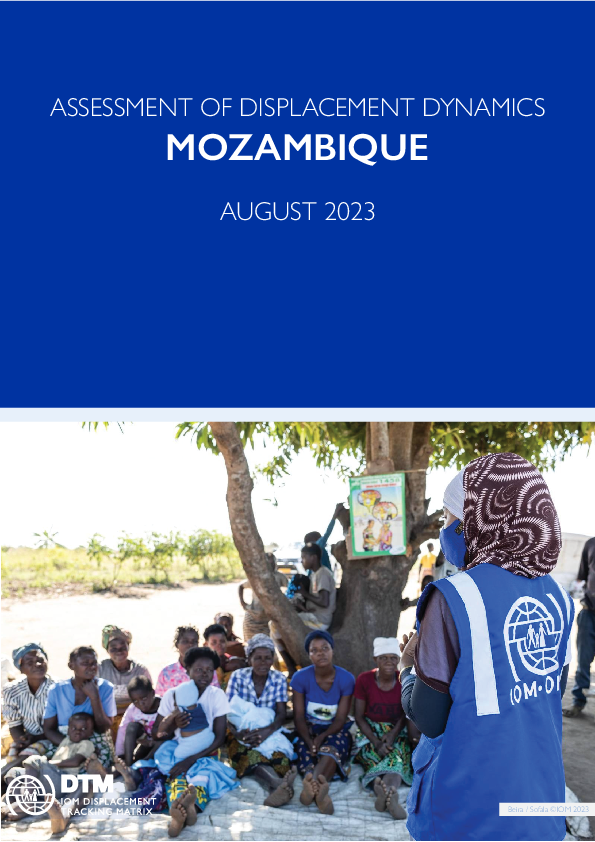
Contact
DTM Mozambique, DTMMozambique@iom.int
Language
English
Location
Mozambique
Period Covered
Jul 12 2023
Aug 04 2023
Activity
- Mobility Tracking
- Baseline Assessment
This summary presents findings of the 19th round of Mobility Tracking Assessments (previously known as Baseline Assessments) conducted across Northern and Central Mozambique through key-informant assessments and group interviews at location level between July and August 2023. Mobility Tracking assessments estimate the presence of internally displaced persons (IDPs) and returnees across Mozambique. IOM DTM mapped a total of 850,599 IDPs and 571,468 returnees in 325 locations. Overall increase on the number of IDPs and Returnees is attributable to the widened coverage. Comparing with previous assessments which covered only Northern Mozambique, the July-August 2023 assessment was widened to cover Manica, Sofala, Tete and Zambezia provinces.

Contact
DTM Mozambique, DTMMozambique@iom.int
Language
English
Location
Mozambique
Period Covered
Feb 16 2023
Mar 16 2023
Activity
- Mobility Tracking
- Site Assessment
This Multi-Sectorial Location Assessment (MSLA) report, which presents findings from the International Organization for Migration’s (IOM) Displacement Tracking Matrix (DTM) Round 11 assessments, aims to enhance understanding of the extent of internal displacements and the needs of affected populations in conflict-affected districts of Northern Mozambique. Data was collected between 16 February and 16 March 2023 in close coordination with provincial government and Instituto Nacional de Gestão e Redução do Risco de Desastres (INGD) partners, and presents trends from 92 assessed sites hosting internally displaced persons across Cabo Delgado, 4 sites in Niassa, and 2 sites in Nampula.
In total, 290,401 internally displaced persons (IDPs) (an increase of 5% since the previous round) or 80,295 households were mapped living in sites assessed during this MSLA. Reported figures, however, exclude displaced individuals living in host community settings. According to DTM Round 18 Mobility Tracking Report, as of April, an estimated 834,304 IDPs were identified living in both host communities and sites (781,679 IDPs in Cabo Delgado, 48,635 IDPs in Nampula, and 3,990 IDPs in Niassa).

Contact
DTM Mozambique, DTMMozambique@iom.int
Language
English
Location
Mozambique
Period Covered
Mar 01 2023
Apr 30 2023
Activity
- Mobility Tracking
This summary presents findings of the 18th round of Mobility Tracking Assessments (previously known as Baseline Assessments) conducted across Northern Mozambique through key-informant assessments and group interviews at district and location-level in March 2023. Mobility Tracking assessments estimate the presence of internally displaced persons (IDPs) and returnees across Northern Mozambique. IOM DTM mapped a total of 834,304 IDPs and 420,200 returnees in 221 locations.
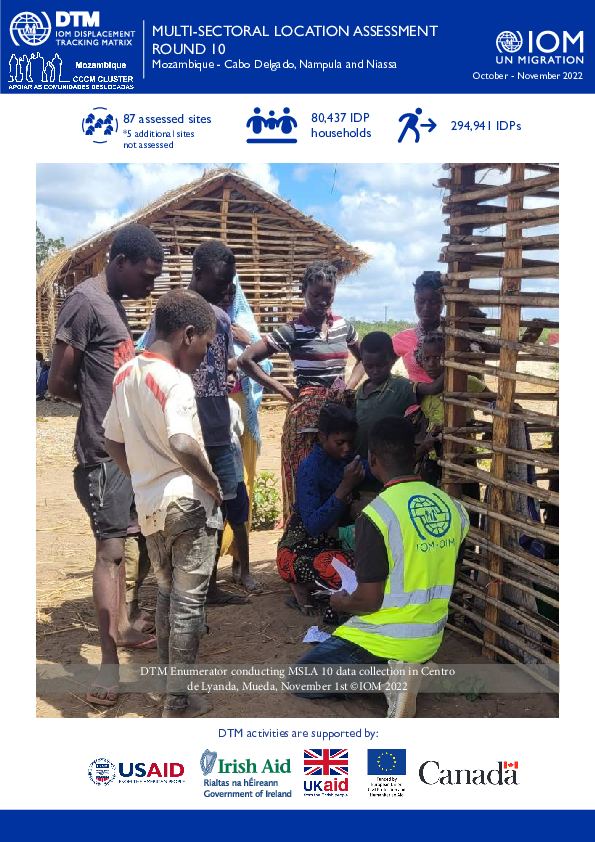
Contact
DTM Mozambique, DTMMozambique@iom.int
Language
English
Location
Mozambique
Period Covered
Oct 17 2022
Nov 15 2022
Activity
- Mobility Tracking
This Multi-Sectorial Location Assessment (MSLA) report, which presents findings from the International Organization for Migration’s (IOM) Displacement Tracking Matrix (DTM) Round 10 assessment, aims to enhance understanding of the extent of internal displacements and the needs of affected populations in conflict-affected districts of Northern Mozambique. Data was collected between 17 October and 17 November 2022 in close coordination with provincial government and Instituto Nacional de Gestão e Redução do Risco de Desastres (INGD) partners and presents trends from 87 assessed sites (including 5 additional sites not assessed) hosting internally displaced persons across fourteen districts in Cabo Delgado, 3 sites in Niassa, and 2 site in Nampula.
In total, 294,941 internally displaced persons (IDPs) (an increase of 6% since the previous round) or 80,437 households were mapped living in sites assessed during this MSLA. Reported figures, however, exclude displaced individuals living in host community settings. According to DTM Round 17 Mobility Tracking Report, as of November, an estimated 935,130 IDPs were identified living in both host communities and sites in Cabo Delgado, 89,016 IDPs in Nampula, and 4,597 IDPs in Niassa.
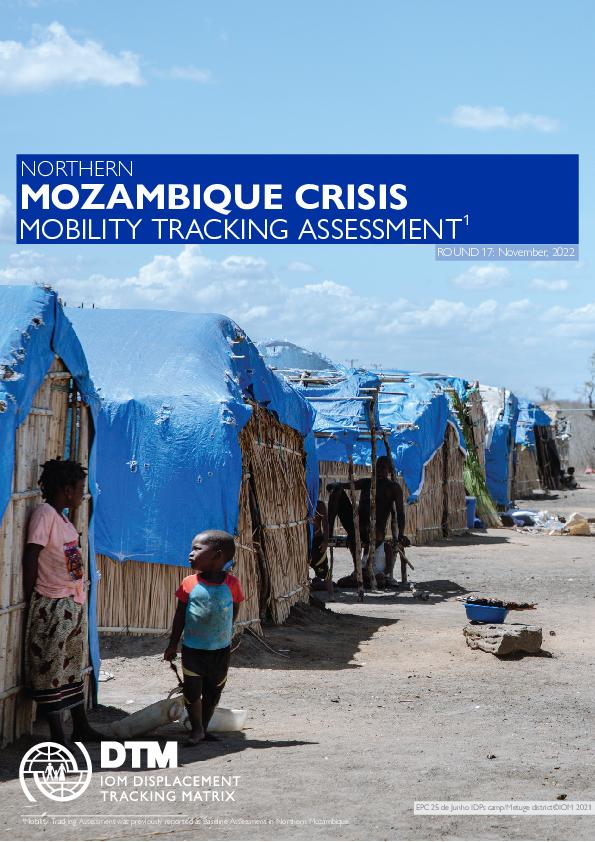
Contact
DTM Mozambique, DTMMozambique@iom.int
Language
English
Location
Mozambique
Period Covered
Oct 16 2022
Nov 16 2022
Activity
- Mobility Tracking
This summary presents findings of the 17th round of Mobility Tracking Assessments (previously known as Baseline Assessments) conducted across Northern Mozambique through key-informant assessments at district and location-level in November 2022. Mobility Tracking assessments estimate the presence of Internally Displaced Persons (IDPs) and returnees across Northern Mozambique in displacement sites and host communities. IOM DTM mapped a total of 1,028,743 IDPs and 352,437 returnees in 238 locations across Northern Mozambique as of November 2022.
Despite the observed presence of returns in newly accessible locations, there remains a significant number of new displacements between June to November 2022 triggered by sporadic attacks in Ancuabe, Balama, Chiure, Erati Meluco, Namuno and Nangade. For the purposes of IOM DTM data collection, the returnee population category is restricted to individuals who have returned to the locations/bairros of their habitual residence, based on a free decision. In Mozambique, displaced persons having returned to districts of origin without having reached their locality of origin are still displaced and as such not counted in the returnee category. The districts of Mocimboa da Praia, Nangade, Quissanga and Macomia continue to host persons in displacement settings who have yet to return to their respective locality of habitual residence (and as such not counted in returnee category).

Contact
DTM Mozambique, DTMMozambique@iom.int
Language
English
Location
Mozambique
Period Covered
May 01 2022
Jun 30 2022
Activity
- Mobility Tracking
- Baseline Assessment
Increased security incidents in northern Mozambique since 2017 resulted in population displacement as well as subsequent humanitarian needs. To better understand the scope of displacement trends and needs of displaced populations, the International Organization for Migration (IOM) activated DTM in Cabo Delgado province in February 2019.
This summary presents findings of the 16th round of Baseline Assessments monitoring displacements triggered by conflict in Northern Mozambique. Key-informant interviews were conducted at district and location-level between May and June 2022. Assessments estimate the presence of 946,508 internally displaced persons (IDPs) mapped across displacement sites and host communities in 212 localities. Security and access restraints in the districts of Nangade, Macomia, Meluco, Mocimboa da Praia, Quissanga, Muidumbe and Palma, have limited data collection to select localities accessible to DTM field teams and focal points.
For this round, 30% of 946,508 IDPs are mapped in relocation sites, temporary centers and host community extensions. Approximately 1% of total IDPs present at the time of assessment were mapped in Pemba (139,566 individuals), followed by Metuge (126,030 individuals), Nangade (116,538 individuals), Mueda (104,270 individuals) and Ancuabe (82,496 individuals).
Pagination
- Page 1
- Next page